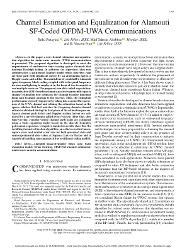| dc.contributor.author | Panayırcı, Erdal | |
| dc.contributor.author | Altabbaa, Mhd Tahssin | |
| dc.contributor.author | Poor, H-Vincent | |
| dc.date.accessioned | 2021-04-24T16:29:51Z | |
| dc.date.available | 2021-04-24T16:29:51Z | |
| dc.date.issued | 2021-02 | |
| dc.identifier.issn | 0018-9545 | en_US |
| dc.identifier.uri | https://hdl.handle.net/20.500.12469/4000 | |
| dc.description.abstract | In this paper, a new channel estimation and equalization algorithm for underwater acoustic (UWA) communications is presented. The proposed algorithm is developed to meet the requirements of underwater time-varying sparse channels that undergo Rayleigh fading. In addition, the algorithm takes into consideration a path-based channel model which describes each received path with significant power by an attenuation factor, a Doppler scale, and a delay. Transmit diversity enabled by Alamouti space-frequency block coding coupled with orthogonal frequency division multiplexing is employed in the form of two transmitters and multiple receivers. The proposed, non-data-aided, expectation-maximization (EM)-based maximum a posteriori probability sparse channel estimation first estimates the channel transfer functions from each transmit antenna to the receiver. Then, the estimation performance is greatly improved by taking into account the sparseness of the UWA channel and refining the estimation based on the sparse solution that best matches the frequency-domain channel estimates obtained during the first phase of the estimation process. Sparse channel path delays and Doppler scaling factors are estimated by a novel technique called delay focusing. After that, slow time-varying, complex-valued channel path gains are estimated using a basis expansion model based on the discrete Legendre polynomial expansion. Computer simulation results show that the resulting channel estimation algorithm can achieve excellent mean-square error and symbol error rate for both generated data and semi-experimental data taken at Sapanca Lake in Turkey and is capable of handling some mismatch due to different fading models. | en_US |
| dc.language.iso | eng | en_US |
| dc.publisher | IEEE-INST ELECTRICAL ELECTRONICS ENGINEERS INC | en_US |
| dc.rights | info:eu-repo/semantics/openAccess | en_US |
| dc.subject | Channel estimation | en_US |
| dc.subject | OFDM | en_US |
| dc.subject | Doppler effect | en_US |
| dc.subject | Delays | en_US |
| dc.subject | Estimation | en_US |
| dc.subject | Underwater acoustics | en_US |
| dc.subject | Focusing | en_US |
| dc.subject | Alamouti space-frequency block code | en_US |
| dc.subject | basis expansion model | en_US |
| dc.subject | Delay focusing | en_US |
| dc.subject | MAP-EM channel estimation | en_US |
| dc.subject | underwater acoustic communications | en_US |
| dc.title | Channel Estimation and Equalization for Alamouti SF-Coded OFDM-UWA Communications | en_US |
| dc.type | article | en_US |
| dc.identifier.startpage | 1709 | en_US |
| dc.identifier.endpage | 1723 | en_US |
| dc.relation.journal | IEEE TRANSACTIONS ON VEHICULAR TECHNOLOGY | en_US |
| dc.identifier.issue | 2 | en_US |
| dc.identifier.volume | 70 | en_US |
| dc.identifier.wos | WOS:000628913700049 | en_US |
| dc.identifier.doi | 10.1109/TVT.2021.3056004 | en_US |
| dc.identifier.scopus | 2-s2.0-85100727430 | en_US |
| dc.institutionauthor | Panayırcı, Erdal | en_US |
| dc.relation.publicationcategory | Makale - Uluslararası Hakemli Dergi - Kurum Öğretim Elemanı | en_US |
















